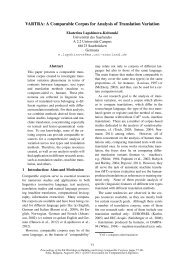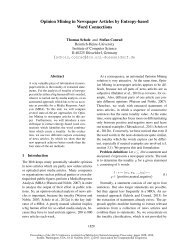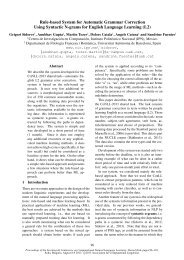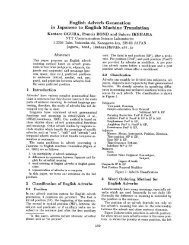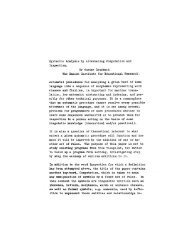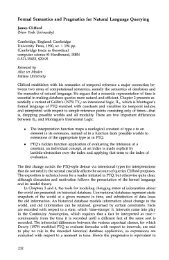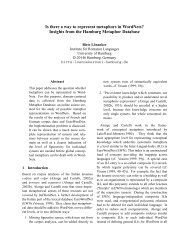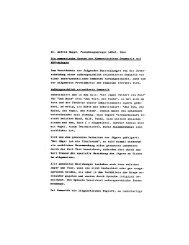Vector Space Semantic Parsing: A Framework for Compositional ...
Vector Space Semantic Parsing: A Framework for Compositional ...
Vector Space Semantic Parsing: A Framework for Compositional ...
Create successful ePaper yourself
Turn your PDF publications into a flip-book with our unique Google optimized e-Paper software.
Input:<br />
Log. Form:<br />
“red ball” → semantic → A<br />
parsing red v ball → evaluation → „ «<br />
◦<br />
◦<br />
↑<br />
↑<br />
„<br />
◦ ◦<br />
◦ ◦<br />
Lexicon: red:= λx.A redx<br />
Params.: A<br />
ball:= v red =<br />
ball<br />
„ «<br />
◦<br />
v ball =<br />
◦<br />
Figure 1: Overview of vector space semantic parsing<br />
(VSSP). A semantic parser first translates natural<br />
language into a logical <strong>for</strong>m, which is then<br />
evaluated to produce a vector.<br />
sitions are functions from a pair of noun vectors<br />
to a noun vector. These semantic type specifications<br />
permit a variety of different composition operations,<br />
many of which cannot be represented in<br />
previously-proposed frameworks. <strong>Parsing</strong> in CCG<br />
applies these functions to each other, naturally deriving<br />
a vector space representation <strong>for</strong> an entire<br />
phrase.<br />
The CCG framework provides function type<br />
specifications <strong>for</strong> each word’s semantics, given its<br />
syntactic category. Instantiating this framework<br />
amounts to selecting particular functions <strong>for</strong> each<br />
word. <strong>Vector</strong> space semantic parsing (VSSP) produces<br />
these per-word functions in a two-step process.<br />
The first step chooses a parametric functional<br />
<strong>for</strong>m <strong>for</strong> each syntactic category, which contains<br />
as-yet unknown per-word and global parameters.<br />
The second step estimates these parameters<br />
using a concrete task of interest, such as predicting<br />
the corpus statistics of adjective-noun compounds.<br />
We present a stochastic gradient algorithm <strong>for</strong> this<br />
step which resembles training a neural network<br />
with backpropagation. These parameters may also<br />
be estimated in an unsupervised fashion, <strong>for</strong> example,<br />
using distributional statistics.<br />
Figure 1 presents an overview of VSSP. The<br />
input to VSSP is a natural language phrase and<br />
a lexicon, which contains the parametrized functional<br />
<strong>for</strong>ms <strong>for</strong> each word. These per-word representations<br />
are combined by CCG semantic parsing<br />
to produce a logical <strong>for</strong>m, which is a symbolic<br />
mathematical <strong>for</strong>mula <strong>for</strong> producing the vector<br />
<strong>for</strong> a phrase – <strong>for</strong> example, A red v ball is a <strong>for</strong>mula<br />
that per<strong>for</strong>ms matrix-vector multiplication.<br />
This <strong>for</strong>mula is evaluated using learned per-word<br />
and global parameters (values <strong>for</strong> A red and v ball )<br />
to produce the language’s vector space representation.<br />
The contributions of this paper are threefold.<br />
«<br />
First, we demonstrate how CCG provides a theoretical<br />
basis <strong>for</strong> vector space models. Second,<br />
we describe VSSP, which is a method <strong>for</strong> concretely<br />
instantiating this theoretical framework.<br />
Finally, we per<strong>for</strong>m experiments comparing VSSP<br />
against other compositional vector space models.<br />
We per<strong>for</strong>m two case studies of composition<br />
using noun-verb-noun and adverb-adjective-noun<br />
phrases, finding that VSSP can learn composition<br />
operations that existing models cannot. We also<br />
find that VSSP produces intuitively reasonable parameters.<br />
2 Combinatory Categorial Grammar <strong>for</strong><br />
<strong>Vector</strong> <strong>Space</strong> Models<br />
Combinatory Categorial Grammar (CCG) (Steedman,<br />
1996) is a lexicalized grammar <strong>for</strong>malism<br />
that has been used <strong>for</strong> both broad coverage syntactic<br />
parsing and semantic parsing. Like other lexicalized<br />
<strong>for</strong>malisms, CCG has a rich set of syntactic<br />
categories, which are combined using a small<br />
set of parsing operations. These syntactic categories<br />
are tightly coupled to semantic representations,<br />
and parsing in CCG simultaneously derives<br />
both a syntactic parse tree and a semantic<br />
representation <strong>for</strong> each node in the parse tree.<br />
This coupling between syntax and semantics motivates<br />
CCG’s use in semantic parsing (Zettlemoyer<br />
and Collins, 2005), and provides a framework <strong>for</strong><br />
building compositional vector space models.<br />
2.1 Syntax<br />
The intuition embodied in CCG is that, syntactically,<br />
words and phrases behave like functions.<br />
For example, an adjective like “red” can combine<br />
with a noun like “ball” to produce another<br />
noun, “red ball.” There<strong>for</strong>e, adjectives are naturally<br />
viewed as functions that apply to nouns and<br />
return nouns. CCG generalizes this idea by defining<br />
most parts of speech in terms of such functions.<br />
Parts of speech in CCG are called syntactic categories.<br />
CCG has two kinds of syntactic categories:<br />
atomic categories and functional categories.<br />
Atomic categories are used to represent<br />
phrases that do not accept arguments. These categories<br />
include N <strong>for</strong> noun, NP <strong>for</strong> noun phrase, S<br />
<strong>for</strong> sentence, and P P <strong>for</strong> prepositional phrase. All<br />
other parts of speech are represented using functional<br />
categories. Functional categories are written<br />
as X/Y or X\Y , where both X and Y are syn-<br />
2



